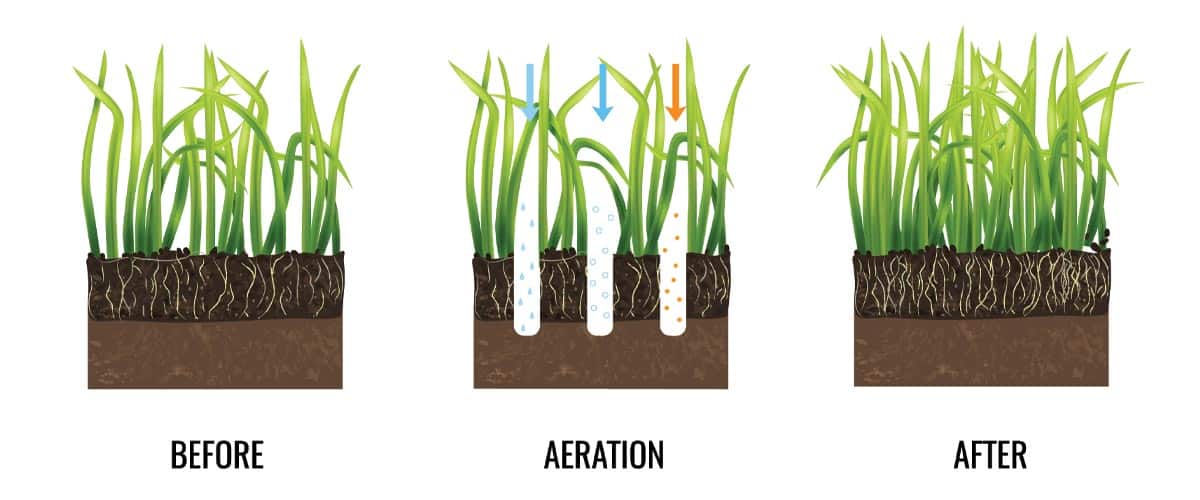Lawn aeration in Charlotte, NC, involves perforating the soil with small holes, allowing air, water, and nutrients to penetrate the grass roots. In the quest for a lush, vibrant lawn, aeration is a pivotal practice that can significantly enhance the health and beauty of your property’s grounds.
This essential procedure encourages deeper root growth, resulting in a more robust and resilient lawn.
Understanding the Benefits of Professional Lawn Aeration
Enhanced Root Growth
By breaking up compacted soil, aeration provides the necessary room for roots to expand, strengthening the foundation of your lawn.
Improved Nutrient Uptake
The aeration process increases the soil’s access to vital nutrients by facilitating deeper penetration, optimizing your lawn’s health and vigor.
Effective Water Utilization
Aerated lawns absorb water more efficiently, reducing runoff and ensuring that moisture reaches the root zone where it’s most needed.
Thatch Reduction
Aeration helps to break down thatch, the layer of dead grass and debris that can suffocate your lawn, by improving microbial activity in the soil.
The Best Time for Lawn Aeration
Determining the perfect moment for lawn aeration is essential for fostering a healthy, lush lawn. For cool-season grasses like Fescue, the optimal aeration period is in September or October. On the other hand, warm-season grasses, including Bermuda, Zoysia, and Centipede, benefit most from aeration in the late spring to early summer. This period is ideal for addressing soil compaction and promoting vigorous growth, as the warmer temperatures and increased sunlight support rapid healing and root development.
Choosing the Right Aeration Method
Core Aeration
This method removes small soil cores from the lawn, which effectively alleviates compaction. The removed cores should be left on the lawn to decompose and return nutrients to the soil.
Spike Aeration
Spike aeration involves poking holes in the ground with a solid tine or fork. While less effective at reducing soil compaction than core aeration, it can benefit lightly compacted soils.
Implementing a Strategic Aeration Plan
To achieve the best results, aeration should be part of a comprehensive lawn maintenance strategy. This includes regular mowing, proper fertilization, and consistent watering practices. Following aeration, it is an opportune time to overseed and apply a top dressing to further enhance lawn health.

Advanced Tips for Lawn Aeration Success
- Soil Moisture: Aerate your lawn when the soil is moist but not saturated, ensuring the easiest and most effective penetration.
- Equipment Selection: Use a high-quality aerator that effectively removes soil cores or penetrates the soil to the appropriate depth.
- Overseeding: After aeration, overseed your lawn to fill in bare spots and improve the overall density and color of your grass.
- Fertilization: Applying fertilizer after aeration can significantly boost the effectiveness of the treatment by facilitating nutrient absorption.
Professional Versus DIY Aeration
While DIY aeration is possible with rental equipment, professional lawn care services offer the advantage of expert knowledge and access to commercial-grade tools. Professionals can assess your lawn’s needs and ensure that aeration is performed effectively and optimally.
Improving Lawn Health
Lawn aeration is a critical component of maintaining a healthy, vibrant garden. By understanding the benefits and best practices associated with aeration, homeowners can significantly improve the health and appearance of their lawns. Whether opting for a DIY approach or enlisting professional services, aeration is a key step in achieving the lush, green lawn of your dreams.
Contact Kept Landscaping for a free quotation.